But won't you get bored?
Tuesday & Friday, June 26 & 29, 2007Kings Canyon National Park, CA
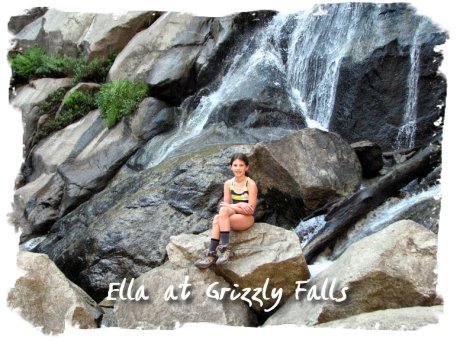
As I sat down on a rock overlooking Grizzly Falls, my niece Ella asked me, “what are you doing?” She and Vance were happily splashing around in the pool underneath the falls, and she couldn’t understand why I wasn’t joining them, neglecting my role as an overgrown playmate.
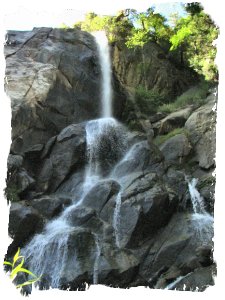 When I told her I was planning on just sitting and watching the falls, she asked me, “but won’t you get bored?” There, in a nutshell, is the divide between child and adult. To Ella and Vance, time is something to be filled, preferably with fun and interesting things – sitting quietly and contemplating a waterfall when one could be swimming under it was not on their agenda.
When I told her I was planning on just sitting and watching the falls, she asked me, “but won’t you get bored?” There, in a nutshell, is the divide between child and adult. To Ella and Vance, time is something to be filled, preferably with fun and interesting things – sitting quietly and contemplating a waterfall when one could be swimming under it was not on their agenda.As an adult, time is something to be savored. “Time is Money!” they say. Denise and I prefer it the other way around. We choose to spend our money on time - free time, time for us, rather than pour it into an ever increasing set of possessions. This decision, made several years ago, is the crux of our lifestyle and the basis for these trips. I sometimes joke that we’ll wind up as greeters at Walmart when everyone else is settling down to their retirement, but that’s okay – we’re investing in time and memories now, while we are young and healthy. The time to sit and savor a small waterfall in the afternoon sun at length is a luxury that I treasure.
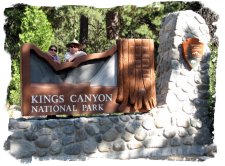 Kings Canyon National Park has a place in our family folklore. My mother’s uncle, Jack Greeley, was a highway engineer for the California Department of Transportation. When I was 17, we took a memorable trip with Uncle Jack and Aunt Hazel into several of the California National Parks – Sequoia, Kings Canyon and Yosemite. Uncle Jack, who was related in some fashion to Horace Greeley of "Go West, Young Man" fame, was the engineer responsible for the on site construction of the road into Kings Canyon.
Kings Canyon National Park has a place in our family folklore. My mother’s uncle, Jack Greeley, was a highway engineer for the California Department of Transportation. When I was 17, we took a memorable trip with Uncle Jack and Aunt Hazel into several of the California National Parks – Sequoia, Kings Canyon and Yosemite. Uncle Jack, who was related in some fashion to Horace Greeley of "Go West, Young Man" fame, was the engineer responsible for the on site construction of the road into Kings Canyon.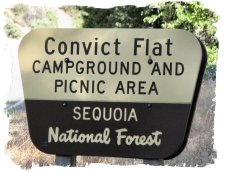 Uncle Jack was full of stories from his road construction days, including a wild story about the construction of the Kings Canyon road. The road was constructed largely with convict labor. Uncle Jack and the convict workers lived at a camp in the canyon (located at today’s ‘Convict Flat’, a Sequoia National Forest Picnic area). Winter storms set in early, and Uncle Jack and the convicts were trapped in the canyon for several months, before new supplies could be shipped in. I’m sure the story was edited somewhat for our childhood ears – I would have loved to have heard the full version, but unfortunately Uncle Jack died several years later.
Uncle Jack was full of stories from his road construction days, including a wild story about the construction of the Kings Canyon road. The road was constructed largely with convict labor. Uncle Jack and the convict workers lived at a camp in the canyon (located at today’s ‘Convict Flat’, a Sequoia National Forest Picnic area). Winter storms set in early, and Uncle Jack and the convicts were trapped in the canyon for several months, before new supplies could be shipped in. I’m sure the story was edited somewhat for our childhood ears – I would have loved to have heard the full version, but unfortunately Uncle Jack died several years later.Our visit on Friday started at the Grants Grove area of the park. Established in 1890 as one of the very first national parks, this sequoia redwood grove was first part of ‘General Grant National Park’, named after the huge General Grant tree. Grant National Park was later absorbed by Kings Canyon NP, although it is actually adjacent to Sequoia National Park. Both Sequoia and Kings Canyon are managed as a single unit, so I suppose it really doesn’t matter in which park the large Sequoia Grove resides. The visitor center had an above average film on the park, including some spectacular scenes of bears in the park.
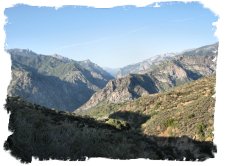 The kids spent some time working on their Jr. Ranger program, then after lunch we drove down into the canyon, following the long, twisty road high on the canyon walls. The views from the road are spectacular. The lower section of the canyon is the traditional V shape of river carved canyons, whereas the upper section is glacier carved, forming a more rounded U shaped bottom. Part of the canyon lies in Sequoia National Forest. Once we reached the canyon floor, we made the stop at Grizzly Falls described above, which is actually in the national forest. The canyon reminds me of a smaller Yosemite, with soaring granite walls and a wooded floor. The Kings River created powerful cascades as it rushed down the canyon.
The kids spent some time working on their Jr. Ranger program, then after lunch we drove down into the canyon, following the long, twisty road high on the canyon walls. The views from the road are spectacular. The lower section of the canyon is the traditional V shape of river carved canyons, whereas the upper section is glacier carved, forming a more rounded U shaped bottom. Part of the canyon lies in Sequoia National Forest. Once we reached the canyon floor, we made the stop at Grizzly Falls described above, which is actually in the national forest. The canyon reminds me of a smaller Yosemite, with soaring granite walls and a wooded floor. The Kings River created powerful cascades as it rushed down the canyon."In the vast Sierra wilderness far to the southward of the famous Yosemite Valley, there is a yet grander valley of the same kind. It is situated on the South Fork of Kings River...beneath the shadows of the highest mountains in the range, where the canyons are deepest, and the snow laden peaks are crowded most closely together...Their general characters, however, are wonderfully alike and they bear the same relationship to the fountains of the ancient glaciers above them"
John Muir - Century Magazine, 1891
Other than the road through part of the canyon, a visitor center and several campgrounds, there isn’t much development in the canyon. Other than Grants Grove, which hosts a good deal of development (Lodge, cabins, stores, etc…), the park is largely a backcountry park – you have to hike it to really appreciate the unspoiled beauty of the area. Some visitors who have previously visited Yosemite express disappointment with the park, feeling it is not as spectacular. But to see what John Muir saw, they need to get their butts out of the car and walk. It's a beautiful and awesome park if you are willing to put some effort into it.
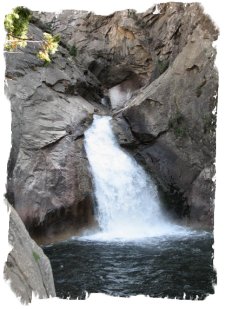 While living in California in the early ‘90s, I took several day hikes deep into the canyon beyond the end of the road. A favorite spot was hiking past a spectacular waterfall (Mist Falls). I was hoping we could hike back in at least to the falls, but discovered that they were further into the canyon than I had remembered (it would be an 8 mile round trip to the falls and back). Feeling that would be a bit ambitious with Vance and Ella, particularly as it was getting into the late afternoon., we decided to fore go the hike. Instead, we enjoyed a short side trip to Roaring River Falls, and then started the long trek back to the campground.
While living in California in the early ‘90s, I took several day hikes deep into the canyon beyond the end of the road. A favorite spot was hiking past a spectacular waterfall (Mist Falls). I was hoping we could hike back in at least to the falls, but discovered that they were further into the canyon than I had remembered (it would be an 8 mile round trip to the falls and back). Feeling that would be a bit ambitious with Vance and Ella, particularly as it was getting into the late afternoon., we decided to fore go the hike. Instead, we enjoyed a short side trip to Roaring River Falls, and then started the long trek back to the campground.The park contains a vast area of High Sierra wilderness, including Mt. Whitney, the highest peak in the lower 48 states. Denise and I have enjoyed reading 'The Last Season', an account of this area and the backcountry rangers who 'live' in the woods on a seasonal basis. The focus of the book is the real life search for Ranger Randy Morgenson, a seasoned backcountry ranger who went missing after 16 years in the park. It's a gripping saga, and gave us a lot of insight into the trials and tribulations of being a ranger, as well as a wonderful description of the High Sierra wilderness.
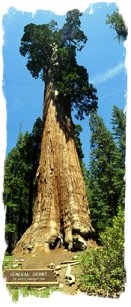 We returned a couple of days later to tour the Grant Grove. The General Grant tree has the largest diameter of any tree in the United States, and is the third largest tree by volume in the world (the largest is the General Sherman Tree in Sequoia NP). After a nice picnic lunch, highlighted by an epic 'King of the Log!!' struggle, we set off on the loop trail to view the giant trees. Many of the trees were named either after states or Civil War leaders, for example, this grove contains the 'General Grant' and the 'General Lee' trees.
We returned a couple of days later to tour the Grant Grove. The General Grant tree has the largest diameter of any tree in the United States, and is the third largest tree by volume in the world (the largest is the General Sherman Tree in Sequoia NP). After a nice picnic lunch, highlighted by an epic 'King of the Log!!' struggle, we set off on the loop trail to view the giant trees. Many of the trees were named either after states or Civil War leaders, for example, this grove contains the 'General Grant' and the 'General Lee' trees.We were determined to end our day with a final visit to Sequoia and a hike to Tokopah Falls where Vance and Ella could enjoy splashing in a swimming hole at the base of the cascades. However, even the best laid plans of mice and men can go awry. You can find out what happened in our next post!

Vance: The first road we took to Kings Canyon made me and Ella very car sick. We never used it again. Kings Canyon is a real canyon formed by water and cut by glaciers. Ella and I got to play at the base of Grizzly Falls. Next we got a great picture next to the Kings Canyon NP sign. Our final stop was Roaring River Falls. If you listen to it, you can hear and understand its name.
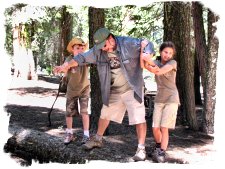 For our next visit we had a picnic and Ella and I enjoyed an epic struggle on a log with my Dad. We also went to Grant’s Grove and saw the Robert E. Lee Tree and the General Grant Tree.
For our next visit we had a picnic and Ella and I enjoyed an epic struggle on a log with my Dad. We also went to Grant’s Grove and saw the Robert E. Lee Tree and the General Grant Tree.THERE ARE NO PICTURES OF ME OR ELLA PLAYING IN THE WATER AT GRIZZLY FALLS BECAUSE WE COULDN’T FIND THE CAMERA!
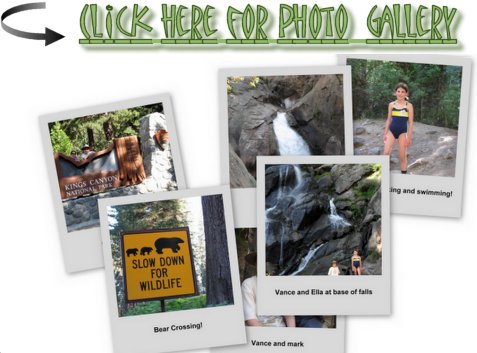
| Prev - Welcome to California | | Home | Index | | Bear Country Jamboree - Next |







<< Home